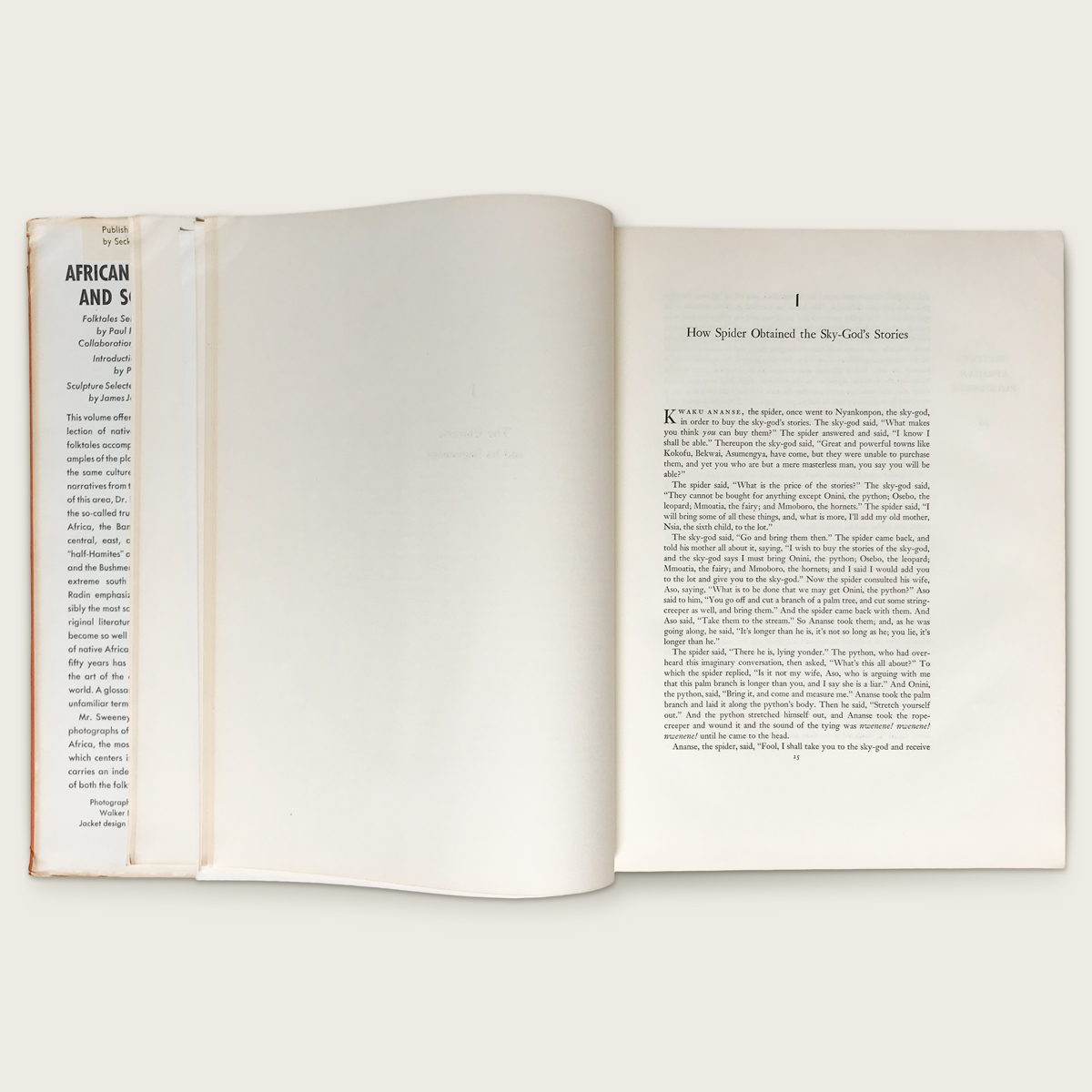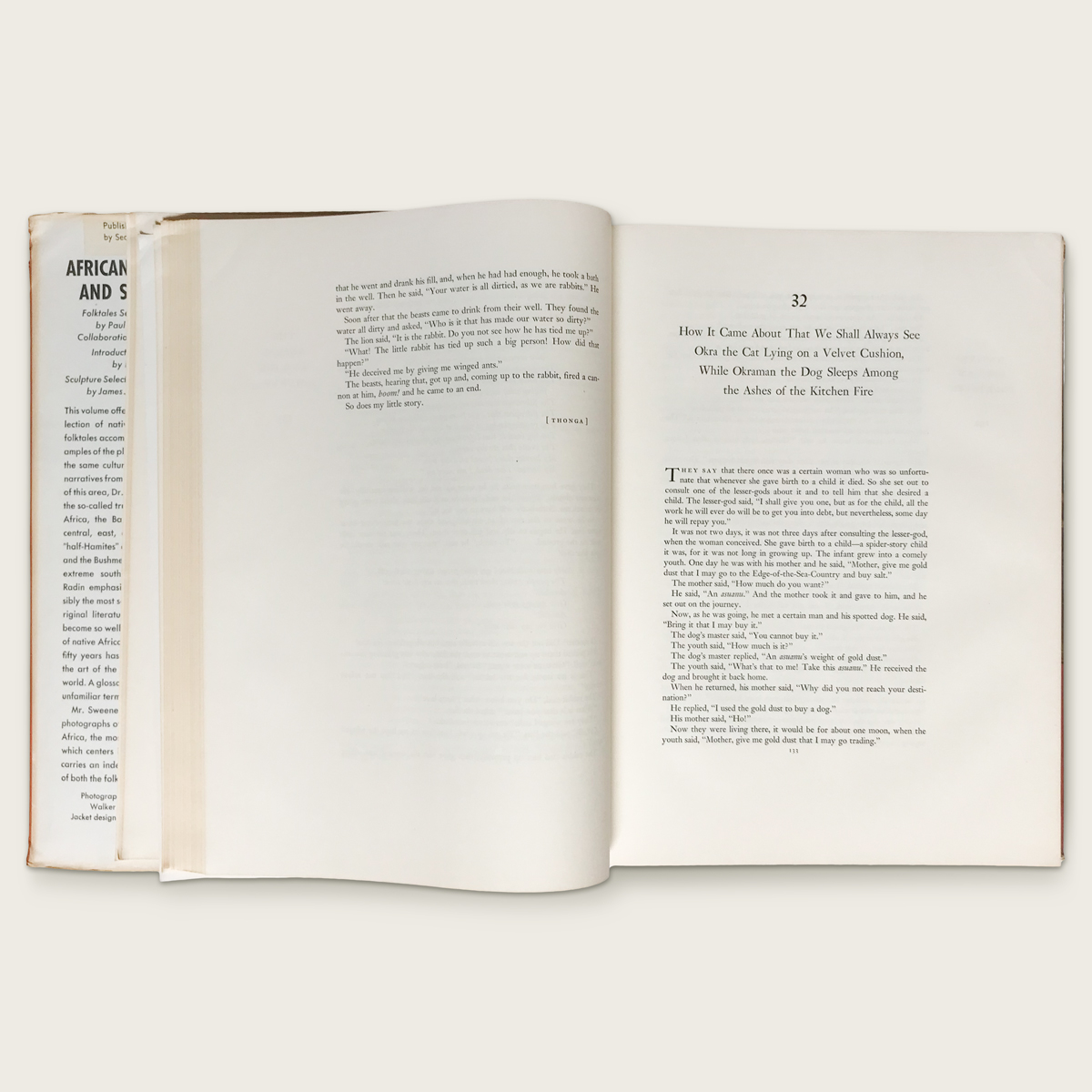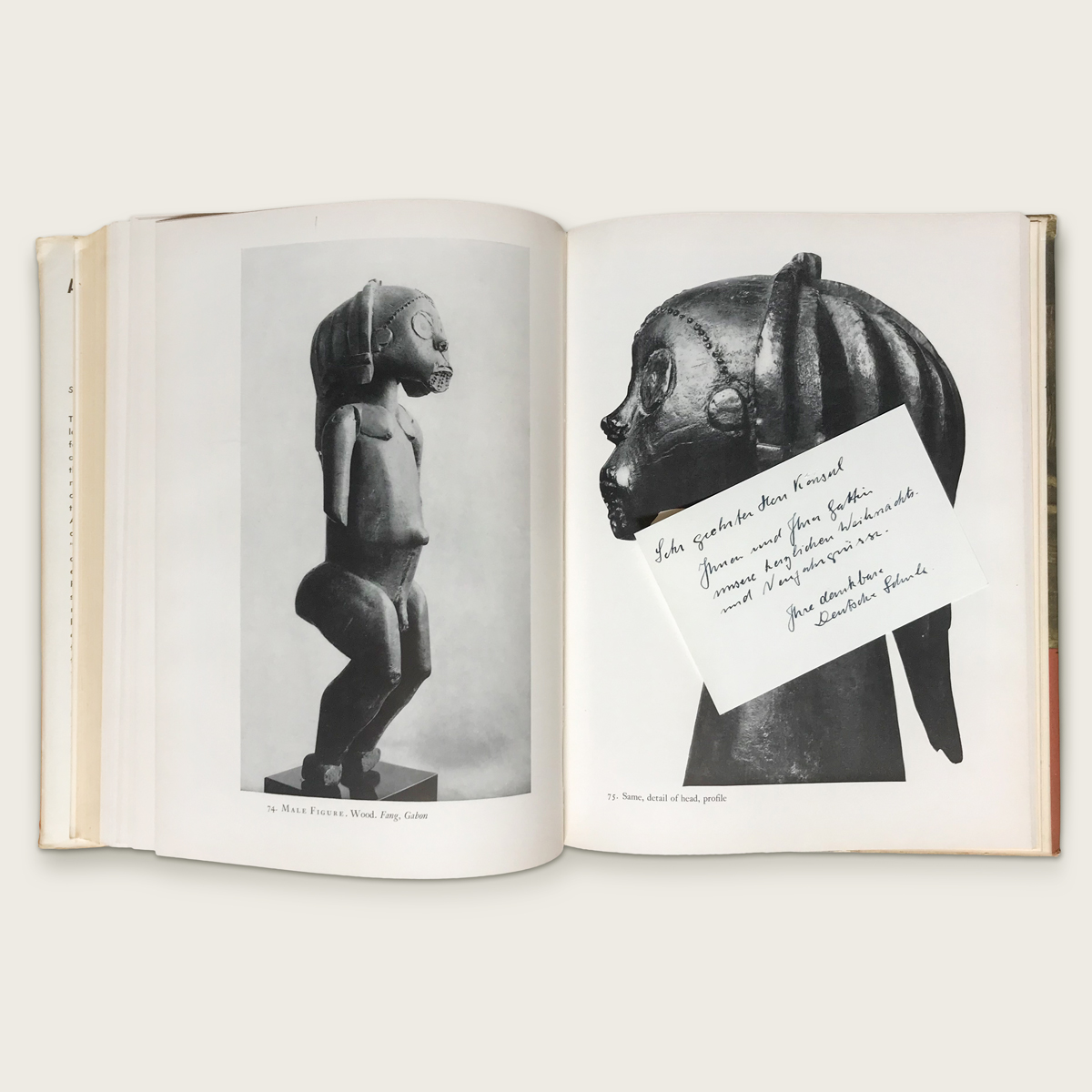African folktales & sculpture. Bollingen series, XXXII.
Edited by Paul Radin, Elinore Marvel, James Johnson Sweeney [photographs by Walker Evans and Eliot Elisofon]
€120,00
New York: Pantheon/Bollingen Foundation Inc., 1953. Second printing. Large 4to (31x24cm), brown textured cloth with golden- lettered spine in price clipped dust jacket. Top- stained red. pp. [6], VII-XII, [1] map, XIII-XXI. [3], 1-335, [3], 165 plates, [2], 341-355. Text in English. Dust jacket shows moderate rubbing and creasing with some chipping on spine- head and edges, but no loss. Small bookplate of Vanguard booksellers Johannesburg at front pastedown. Upper corner of the first pages slightly dog-eared. Laid in handwritten note to the German consul and his wife from the German school. Near fine copy in a good dust jacket.
With African folktales & sculpture Paul Radin, an American cultural anthropologist and folklorist, wanted to correct the false impression that native African folk literature was just a simple form of literature, dealing mainly with animal stories. By assembling a collection of African myths and folktales with a selection of plastic art photographed, among others, by Walker Evans and Eliot Elisofon, Radin wanted to make clear that African folk literature is probably the most sophisticated of all indigenous literatures.
African folktales & sculpture presents eighty- one narratives that are grouped into four sections: The Universe and Its Beginnings, The Animal and His World, The Realm of Man, and Man and His Fate.
The photographs of Walker Evans in this book originate from a portfolio he made for the 1935 African Negro Art exhibition at the Museum of Modern Art in New York. The exhibition was organized by Alfred H. Barr Jr., the director of the MoMa, together with James Johnson Sweeney, who also edited the images of sculptures for this book.
The bookplate in African folktales & sculpture belongs to the legendary Johannesburg bookstore Vanguard that was founded by Fanny Klenerman in 1931 and existed until 1974.
Fanny Klenerman immigrated to South Africa from Latvia with her family in 1897 and became politically active at a young age. For a short time she was a member of the Communist Party of South Africa [CPSA], but was quickly expelled for criticizing the party. Later she joined the South African Workers’ Party, the Industrial and Commercial Workers Union [ICU], the Jewish Workers Club, and was also the co-founder of the SA Women Workers Union. She was a Trotskyist and trade unionist all her life. Journalist David Robbins quotes the recollections of a former Vanguard employee in his book Wasteland from 1987:
“During the war[…] I got a job in a bookshop, Vanguard, it was called, and it was run by perfectly crazy people – they were Trotskyites actually. Of course during those days we were heavily dependent on imported culture, on books from London and America. When consignments of new books arrived, everyone who was anyone came to browse. The shop stayed open on Saturday afternoons, and it was like a social occasion. I could name you at least fifty top people around today who all had accounts at the Vanguard […] And of course, Vanguard was an important meeting place for Black and White intellectuals. It was probably the only place they could meet in those days.”
Due to the political situation in South Africa and the beginning of the apartheid regime, Klenerman was forced to change the location of her bookstore several times. The bookplate shows the address of Joubert Street 23 in Johannesburg, which was already the fifth location for the Vanguard bookstore. Located in a basement of a dilapidated building that the Johannesburg Building Society wanted to restore, it lasted from 1952 to 1966, before the bookstore moved again to Commissioner Street.
The handwritten note, which is laid in the book, adds another interesting layer to the story.
“Sehr geehrter Herr Konsul, Ihnen und Ihrer Gattin unsere herzlichsten Weihnachts- und Neujahrsgrüsse. Ihre dankbare Deutsche Schule”
[Dear Consul, to you and your wife our warmest Christmas and New Year greetings. Your grateful German School]
Given the year of publication of the second printing in 1953 and the address on the bookplate, which helps to narrow down the time period more precisely the book must have been purchased between 1953 and 1966, as a Christmas gift for the German consul, at Fanny Klenerman’s Vanguard bookstore at 23 Joubert Street.
Into this time frame would fit most likley the first postwar German consul, Rudolf Holzheimer, who took office in 1951, before taking over the embassy in Cairo in September 1954, followed by Gustav Strohm (1955–1957), Hans Ulrich Granow (1958–1961), Karl Overbeck (1961–1963), and Werner Junker (1963–1967).
With the exception of Rudolf Holzheimer, who joined the foreign service of the German Reich already in 1919, but worked during the Second World War for the signals intelligence and cryptanalytic agency of the German Nazi Party, all of his named successors were former members of the NSDAP.
This book is a fantastic example of how books can overlay important moments and periods of history within them, and also illustrates the historical value that a bookseller and book owner can bring to a book.













![Artsept: cahiers trimestriels de documentation cinématographique [complete set]](https://chunkingbooks.com/wp-content/uploads/2021/04/artsept_01-1-300x300.jpg)

![[Chris Marker] SPECTACLES N°1: Cahiers d’Art du Theatre et du Cinéma](https://chunkingbooks.com/wp-content/uploads/2021/04/spectacles_01-300x300.jpg)
Commentaires, Commentaires 2
by Chris Marker
€650,00 Enquery